Description
Entered into service in 1935, the OTO Mod. 35, together with the SRCM Mod. 35 and the Breda Mod. 35 represented the new generation of hand grenades with which the Regio Esercito faced the Second World War. It is an offense type hand grenade consisting of an aluminium body bomb painted red, contains 36 g of TNT that at the time of the explosion fragment a ball of lead containing lead pellets. [1]
The O.T.O. is the simplest of the three Mod.35 Types. The Allways fuze is driven by a lead ball held between a cone shaped cap and a spring loaded striker. An interesting feature is the design on the ball, it's a lead-wrapped assembly of small lead shot, intended to rupture at the moment of detonation, a safety feature. Since the grenade was an offensive type, designers didn't want to have a heavy part of the bomb flying far away from the intended point of detonation and possibly injuring the thrower. That's the reason why the ball should break into tiny parts at the moment of detonation. [2] The internal capsule contains the explosive and a primer/detonator tube. A thin wire ring locks the two body halves together at a specific place, fixing the overall length, so as not to bind the internal parts.
Operational use
To use, the pull tab with the attached safety strip is withdrawn, just prior to throwing, unlocking the safety lever. When thrown the lever was to catch the air and be pulled from the grenade, removing the safety bar from between the firing pin and the primer. This was an open terrain grenade, as some amount of time and distance was required to allow the mechanism to function properly, which it had a tendency not to do.

"Mills bomb" is the popular name for a series of British hand grenades which were designed by William Mills. They were the first modern fragmentation grenades used by the British Army and saw widespread use in the First and Second World Wars.
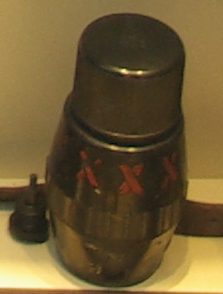
The British No. 69 was a hand grenade developed and used during the Second World War. It was adopted into service due to the need for a grenade with smaller destructive radius than the No. 36M "Mills bomb". This allowed the thrower to use a grenade even when there was little in the way of defensive cover. In contrast, the much greater destructive radius of the Mills bomb than its throwing range forced users to choose their throwing point carefully, in order to ensure that they would not be wounded by the shrapnel explosion of their own grenade.
OTO Melara was a subsidiary of the Italian company Finmeccanica, today Leonardo, active in the defence sector, with factories in Brescia and La Spezia. The Mod 56 pack howitzer, in service throughout the world, and the 76mm naval gun, adopted by 53 navies and installed on over 1,000 naval vessels, are among OTO Melara's best known weapons since World War II.
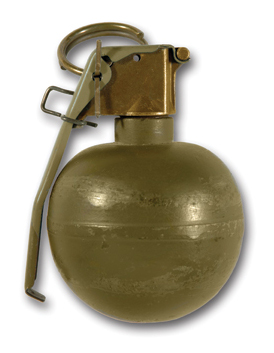
The M67 grenade is a fragmentation hand grenade used by the United States military. The M67 is a further development of the M33 grenade, itself a replacement for the M26-series grenades used during the Korean and Vietnam Wars, and the older Mk 2 "pineapple" grenade used since World War I.
The military of the United States has used many different types of hand grenades since its foundation.

The HG 85 is a round fragmentation hand grenade designed for the Swiss Armed Forces and still produced by RUAG Ammotec in Switzerland. HG 85 is the internal designation of the Swiss Army and replaces the HG 43 from World War II.

The Kugelhandgranate is a model of hand thrown fragmentation grenade manufactured in Germany, also known as Mod. 1913.
In military munitions, a fuze is the part of the device that initiates function. In some applications, such as torpedoes, a fuze may be identified by function as the exploder. The relative complexity of even the earliest fuze designs can be seen in cutaway diagrams.

A grenade is an explosive weapon typically thrown by hand, but can also refer to a shell shot from the muzzle of a rifle or a grenade launcher. A modern hand grenade generally consists of an explosive charge ("filler"), a detonator mechanism, an internal striker to trigger the detonator, an arming safety secured by a transport safety. The user removes the transport safety before throwing, and once the grenade leaves the hand the arming safety gets released, allowing the striker to trigger a primer that ignites a fuze, which burns down to the detonator and explodes the main charge.
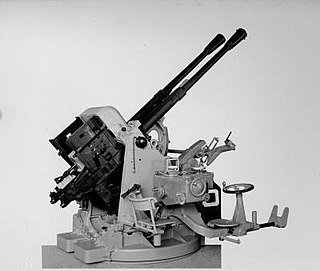
The Cannone-Mitragliera da 37/54 (Breda) was a 37 mm (1.5 in) automatic anti-aircraft gun produced by the Breda company in Italy.
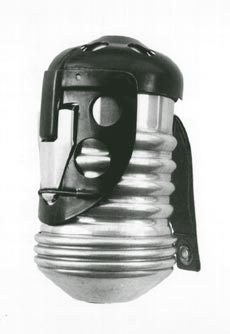
The Breda Mod. 35 is a hand grenade issued to the Royal Italian Army during World War II.

The Breda Mod. 42 was an anti-tank grenade, developed by Breda, supplied to the Royal Italian Army during World War II.

The SRCM Mod. 35 is a hand grenade that was first issued to the Royal Italian Army in 1935, serving through World War II and into the 1980s. Nicknamed "Red Devils" by the British in 1941–1942 during the North African Campaign after the red color of the most common type.
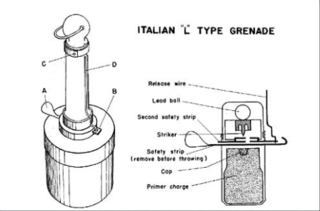
The Type L is an anti-tank hand grenade provided to the Royal Italian Army during World War II.

The OD 82 / SE is a hand grenade, currently issued to the Italian Army.

The OTO Mod. 42 is an incendiary anti-tank hand grenade supplied to the Royal Italian Army during World War II.

Passaglia Grenades, also known as P Bombs or Pazzaglia, are homemade weapons used by Italian soldiers during World War II, especially in the North African theater to overcome the chronic lack of effective weapons against armored enemies.

The 3.7 cm Infanteriegeschütz M.15 was an Austro-Hungarian cannon developed for use in the trenches during the First World War. The name indicates the caliber in centimeters, the gun's role Infanteriegeschütz which in German means infantry support gun and the model according to the year of introduction. Captured Austrian guns and Italian produced copies were first designated Cannon 37F and later as 37/10 F. Mod. 1915 in the 1930s.
The SFG 87 is a defensive fragmentation hand grenade created in Singapore. It is one of the grenades used for infantry divisions of the Singapore Armed Forces. The grenades are produced mainly by Singaporean weapons manufacturer ST Kinetics. It has been mass-produced since 1987, replacing the older SFG 82 and SFG 75 variants.
This page is based on this
Wikipedia article Text is available under the
CC BY-SA 4.0 license; additional terms may apply.
Images, videos and audio are available under their respective licenses.













